Evaluating the Australian National Diabetes Strategy 2016-2020 Impact
VerifiedAdded on 2022/12/29
|9
|2189
|38
Report
AI Summary
This report provides an analysis of the Australian National Diabetes Strategy 2016-2020, examining its impact on nursing practices and the broader healthcare system. It highlights the strategy's goals, which include outlining Australia's national response to diabetes and improving healthcare resource allocation. The report identifies key factors such as leadership, workforce development, and research, and it addresses barriers like resource shortages and inadequate training for nurses. It also emphasizes the importance of national food and physical activity plans and the role of primary health networks in reducing complexity within healthcare systems. The analysis draws upon various studies and surveys to assess the effectiveness of the strategy's interventions and its influence on patient safety, ultimately concluding that the strategy has a positive impact by promoting collaboration, integrating care, and reducing health inequalities, leading to improved diabetes management and healthcare outcomes.
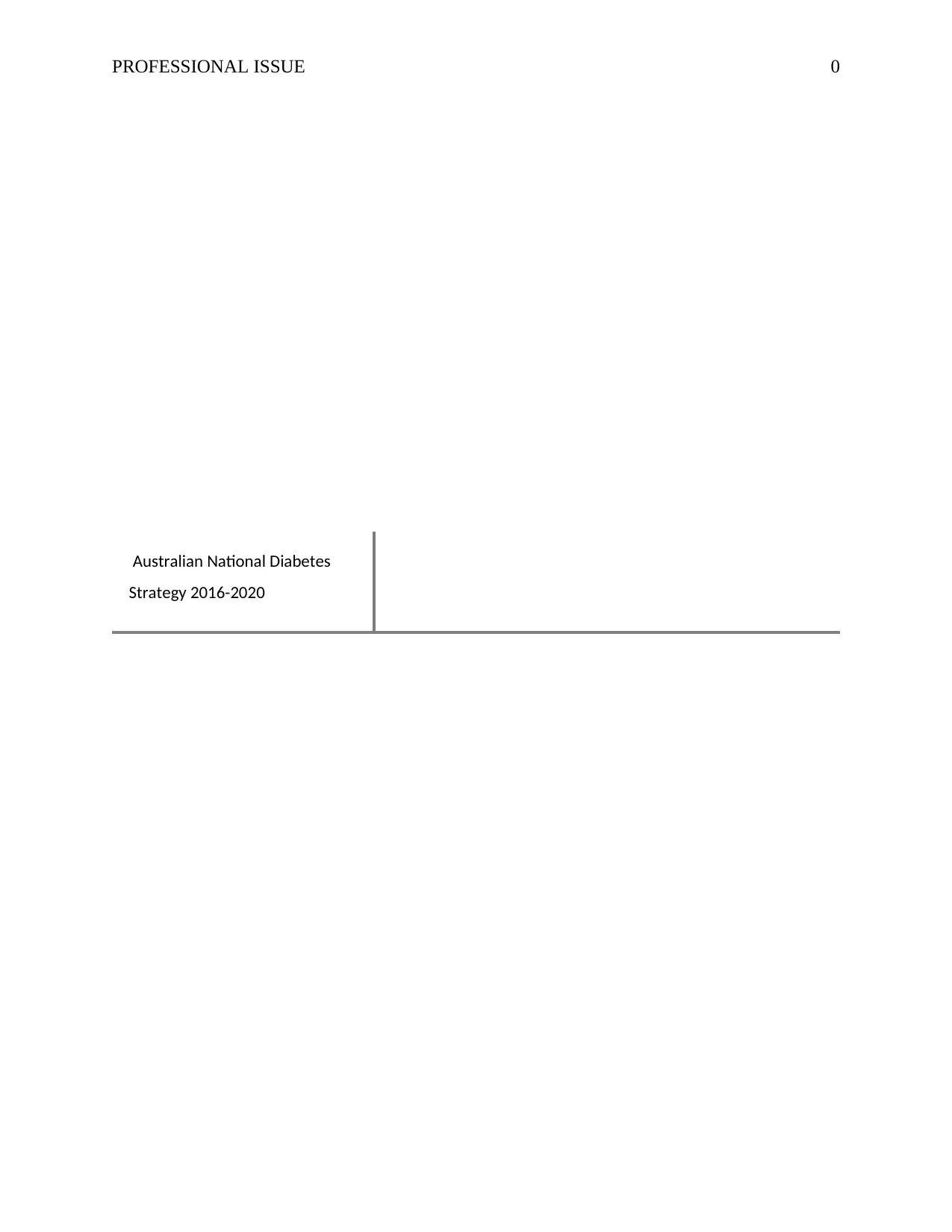
PROFESSIONAL ISSUE 0
Australian National Diabetes
Strategy 2016-2020
Australian National Diabetes
Strategy 2016-2020
Paraphrase This Document
Need a fresh take? Get an instant paraphrase of this document with our AI Paraphraser
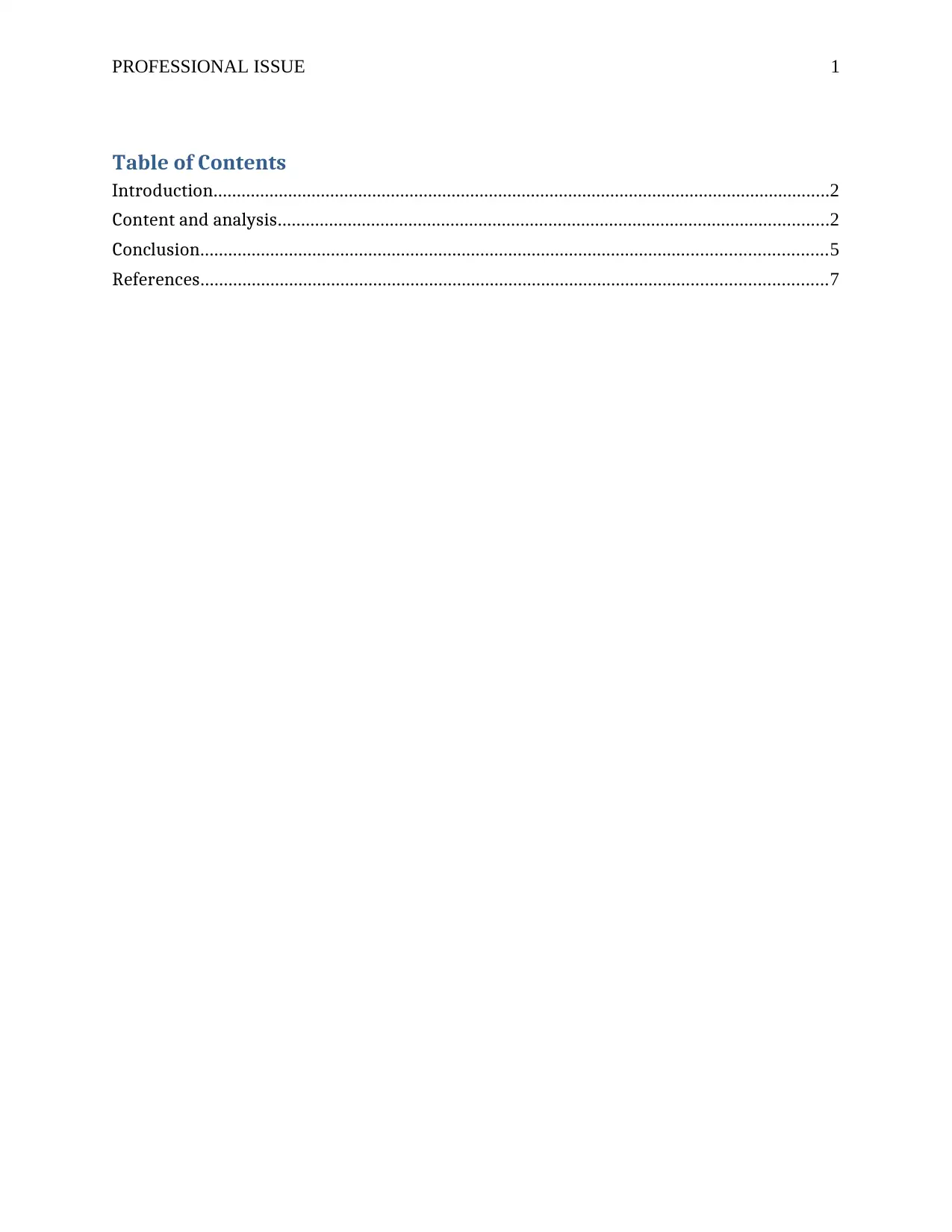
PROFESSIONAL ISSUE 1
Table of Contents
Introduction....................................................................................................................................2
Content and analysis......................................................................................................................2
Conclusion......................................................................................................................................5
References......................................................................................................................................7
Table of Contents
Introduction....................................................................................................................................2
Content and analysis......................................................................................................................2
Conclusion......................................................................................................................................5
References......................................................................................................................................7
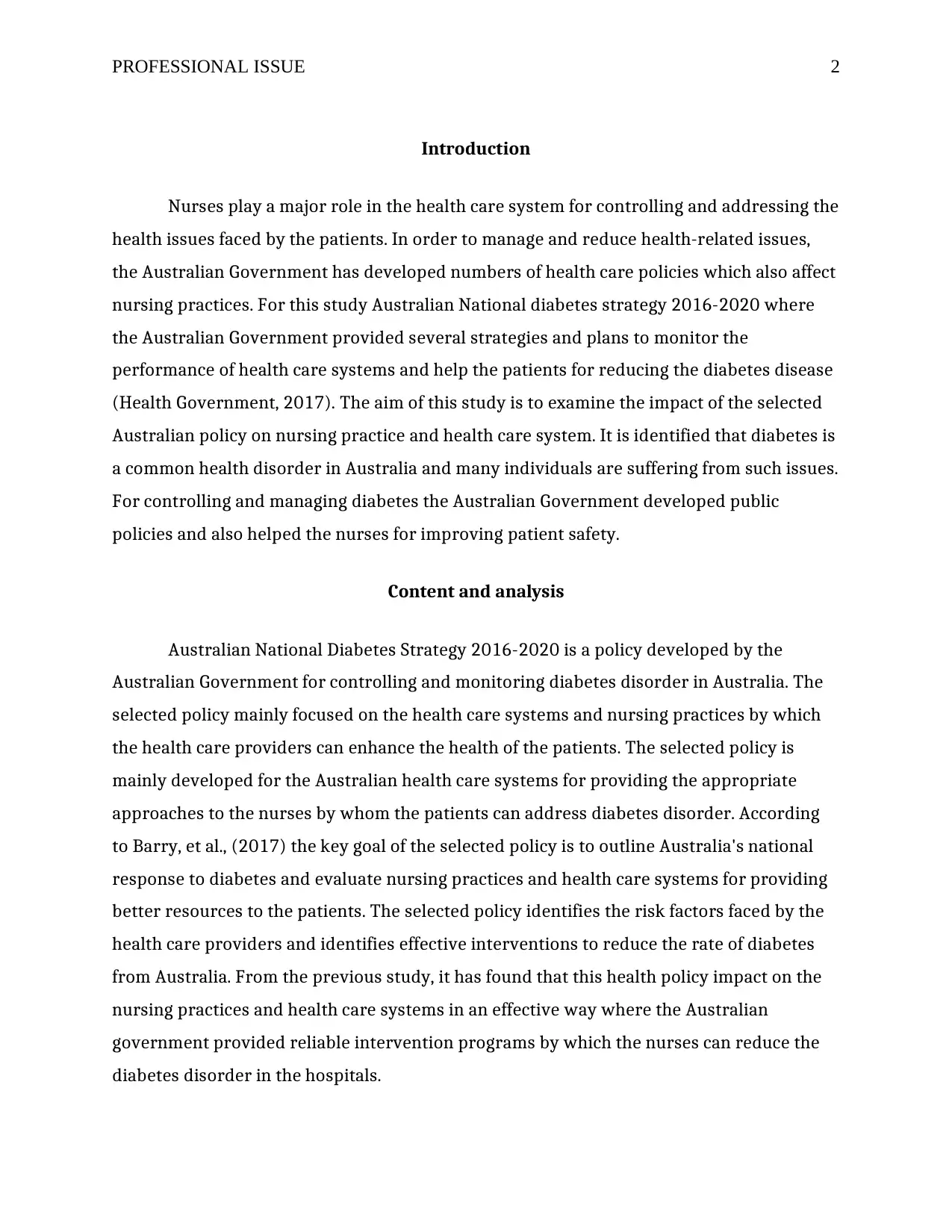
PROFESSIONAL ISSUE 2
Introduction
Nurses play a major role in the health care system for controlling and addressing the
health issues faced by the patients. In order to manage and reduce health-related issues,
the Australian Government has developed numbers of health care policies which also affect
nursing practices. For this study Australian National diabetes strategy 2016-2020 where
the Australian Government provided several strategies and plans to monitor the
performance of health care systems and help the patients for reducing the diabetes disease
(Health Government, 2017). The aim of this study is to examine the impact of the selected
Australian policy on nursing practice and health care system. It is identified that diabetes is
a common health disorder in Australia and many individuals are suffering from such issues.
For controlling and managing diabetes the Australian Government developed public
policies and also helped the nurses for improving patient safety.
Content and analysis
Australian National Diabetes Strategy 2016-2020 is a policy developed by the
Australian Government for controlling and monitoring diabetes disorder in Australia. The
selected policy mainly focused on the health care systems and nursing practices by which
the health care providers can enhance the health of the patients. The selected policy is
mainly developed for the Australian health care systems for providing the appropriate
approaches to the nurses by whom the patients can address diabetes disorder. According
to Barry, et al., (2017) the key goal of the selected policy is to outline Australia's national
response to diabetes and evaluate nursing practices and health care systems for providing
better resources to the patients. The selected policy identifies the risk factors faced by the
health care providers and identifies effective interventions to reduce the rate of diabetes
from Australia. From the previous study, it has found that this health policy impact on the
nursing practices and health care systems in an effective way where the Australian
government provided reliable intervention programs by which the nurses can reduce the
diabetes disorder in the hospitals.
Introduction
Nurses play a major role in the health care system for controlling and addressing the
health issues faced by the patients. In order to manage and reduce health-related issues,
the Australian Government has developed numbers of health care policies which also affect
nursing practices. For this study Australian National diabetes strategy 2016-2020 where
the Australian Government provided several strategies and plans to monitor the
performance of health care systems and help the patients for reducing the diabetes disease
(Health Government, 2017). The aim of this study is to examine the impact of the selected
Australian policy on nursing practice and health care system. It is identified that diabetes is
a common health disorder in Australia and many individuals are suffering from such issues.
For controlling and managing diabetes the Australian Government developed public
policies and also helped the nurses for improving patient safety.
Content and analysis
Australian National Diabetes Strategy 2016-2020 is a policy developed by the
Australian Government for controlling and monitoring diabetes disorder in Australia. The
selected policy mainly focused on the health care systems and nursing practices by which
the health care providers can enhance the health of the patients. The selected policy is
mainly developed for the Australian health care systems for providing the appropriate
approaches to the nurses by whom the patients can address diabetes disorder. According
to Barry, et al., (2017) the key goal of the selected policy is to outline Australia's national
response to diabetes and evaluate nursing practices and health care systems for providing
better resources to the patients. The selected policy identifies the risk factors faced by the
health care providers and identifies effective interventions to reduce the rate of diabetes
from Australia. From the previous study, it has found that this health policy impact on the
nursing practices and health care systems in an effective way where the Australian
government provided reliable intervention programs by which the nurses can reduce the
diabetes disorder in the hospitals.
⊘ This is a preview!⊘
Do you want full access?
Subscribe today to unlock all pages.

Trusted by 1+ million students worldwide
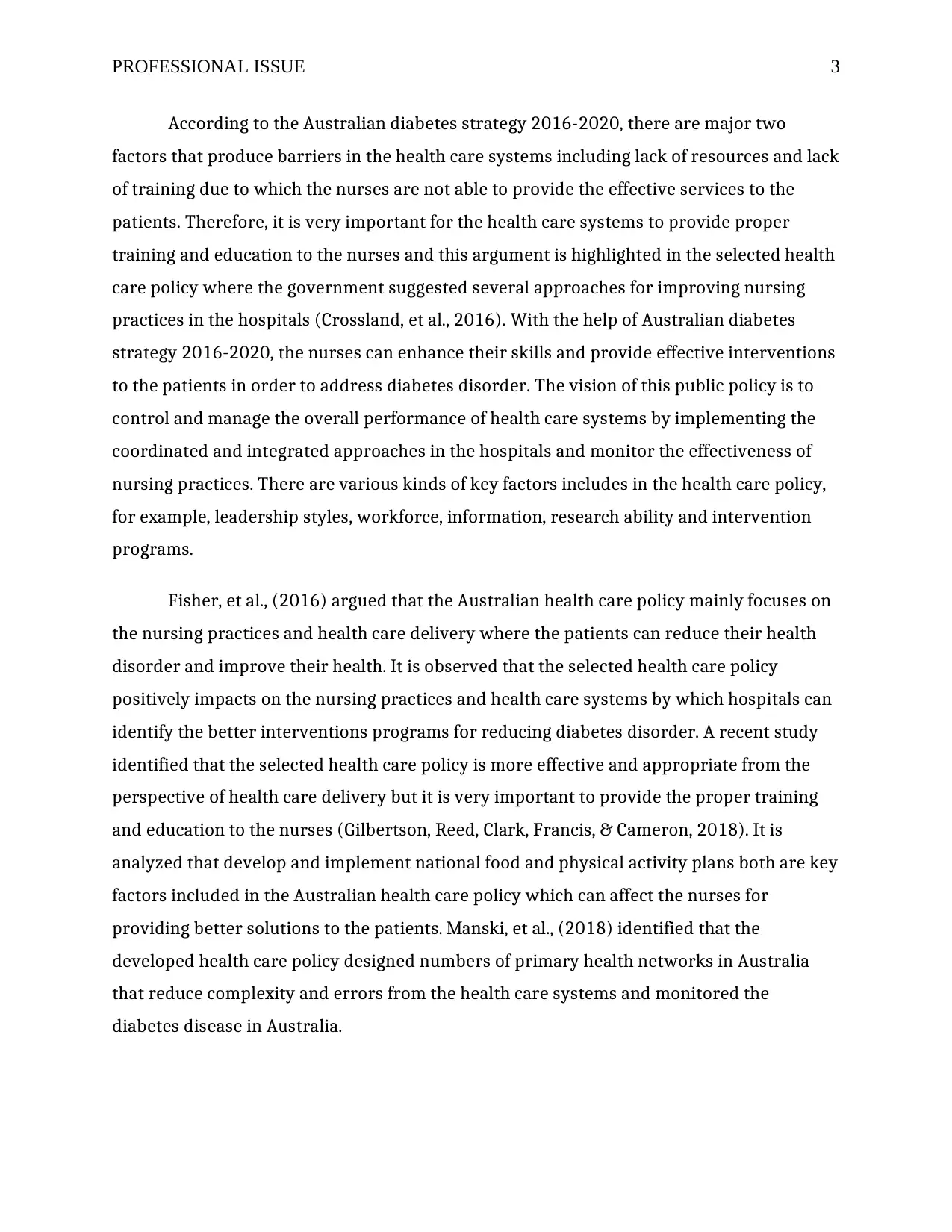
PROFESSIONAL ISSUE 3
According to the Australian diabetes strategy 2016-2020, there are major two
factors that produce barriers in the health care systems including lack of resources and lack
of training due to which the nurses are not able to provide the effective services to the
patients. Therefore, it is very important for the health care systems to provide proper
training and education to the nurses and this argument is highlighted in the selected health
care policy where the government suggested several approaches for improving nursing
practices in the hospitals (Crossland, et al., 2016). With the help of Australian diabetes
strategy 2016-2020, the nurses can enhance their skills and provide effective interventions
to the patients in order to address diabetes disorder. The vision of this public policy is to
control and manage the overall performance of health care systems by implementing the
coordinated and integrated approaches in the hospitals and monitor the effectiveness of
nursing practices. There are various kinds of key factors includes in the health care policy,
for example, leadership styles, workforce, information, research ability and intervention
programs.
Fisher, et al., (2016) argued that the Australian health care policy mainly focuses on
the nursing practices and health care delivery where the patients can reduce their health
disorder and improve their health. It is observed that the selected health care policy
positively impacts on the nursing practices and health care systems by which hospitals can
identify the better interventions programs for reducing diabetes disorder. A recent study
identified that the selected health care policy is more effective and appropriate from the
perspective of health care delivery but it is very important to provide the proper training
and education to the nurses (Gilbertson, Reed, Clark, Francis, & Cameron, 2018). It is
analyzed that develop and implement national food and physical activity plans both are key
factors included in the Australian health care policy which can affect the nurses for
providing better solutions to the patients. Manski, et al., (2018) identified that the
developed health care policy designed numbers of primary health networks in Australia
that reduce complexity and errors from the health care systems and monitored the
diabetes disease in Australia.
According to the Australian diabetes strategy 2016-2020, there are major two
factors that produce barriers in the health care systems including lack of resources and lack
of training due to which the nurses are not able to provide the effective services to the
patients. Therefore, it is very important for the health care systems to provide proper
training and education to the nurses and this argument is highlighted in the selected health
care policy where the government suggested several approaches for improving nursing
practices in the hospitals (Crossland, et al., 2016). With the help of Australian diabetes
strategy 2016-2020, the nurses can enhance their skills and provide effective interventions
to the patients in order to address diabetes disorder. The vision of this public policy is to
control and manage the overall performance of health care systems by implementing the
coordinated and integrated approaches in the hospitals and monitor the effectiveness of
nursing practices. There are various kinds of key factors includes in the health care policy,
for example, leadership styles, workforce, information, research ability and intervention
programs.
Fisher, et al., (2016) argued that the Australian health care policy mainly focuses on
the nursing practices and health care delivery where the patients can reduce their health
disorder and improve their health. It is observed that the selected health care policy
positively impacts on the nursing practices and health care systems by which hospitals can
identify the better interventions programs for reducing diabetes disorder. A recent study
identified that the selected health care policy is more effective and appropriate from the
perspective of health care delivery but it is very important to provide the proper training
and education to the nurses (Gilbertson, Reed, Clark, Francis, & Cameron, 2018). It is
analyzed that develop and implement national food and physical activity plans both are key
factors included in the Australian health care policy which can affect the nurses for
providing better solutions to the patients. Manski, et al., (2018) identified that the
developed health care policy designed numbers of primary health networks in Australia
that reduce complexity and errors from the health care systems and monitored the
diabetes disease in Australia.
Paraphrase This Document
Need a fresh take? Get an instant paraphrase of this document with our AI Paraphraser
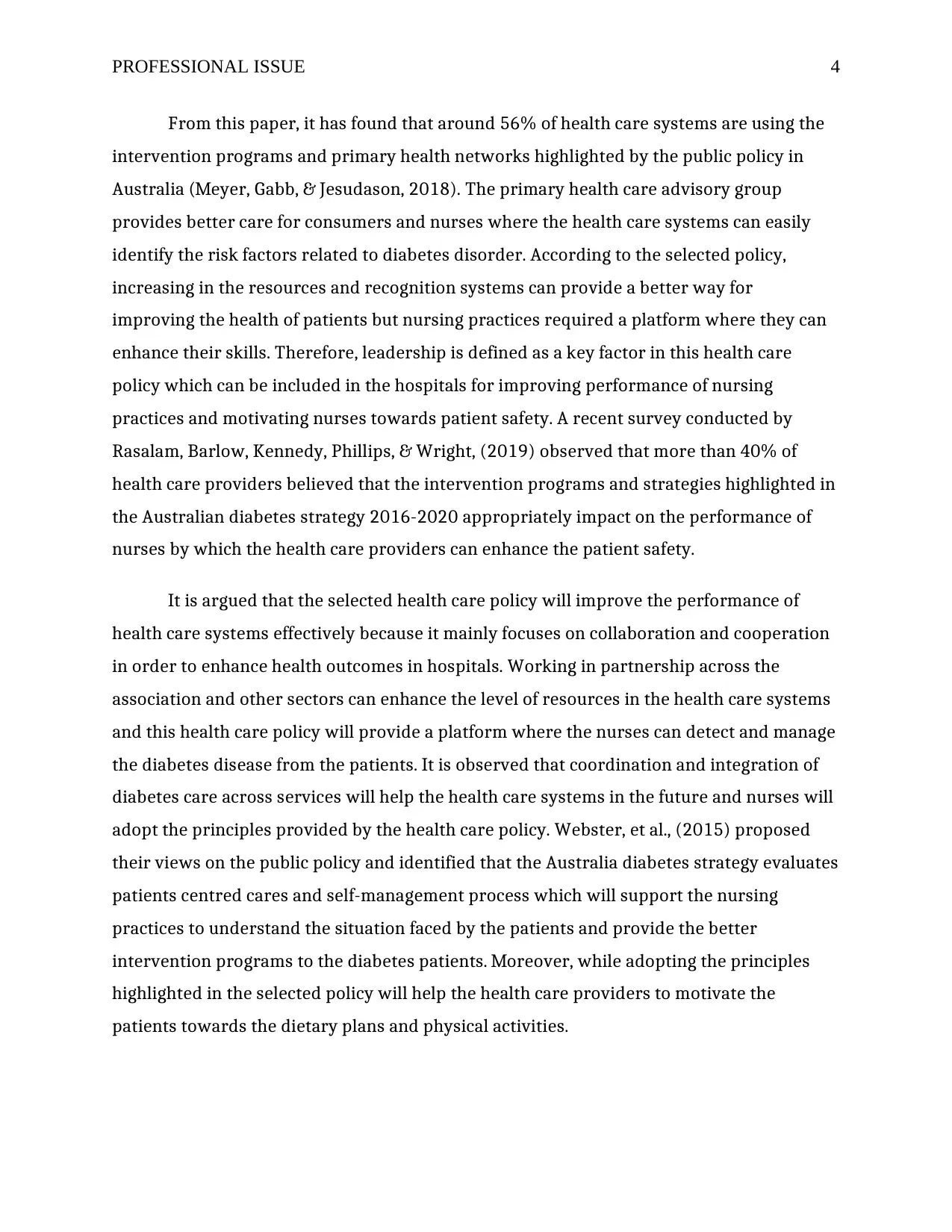
PROFESSIONAL ISSUE 4
From this paper, it has found that around 56% of health care systems are using the
intervention programs and primary health networks highlighted by the public policy in
Australia (Meyer, Gabb, & Jesudason, 2018). The primary health care advisory group
provides better care for consumers and nurses where the health care systems can easily
identify the risk factors related to diabetes disorder. According to the selected policy,
increasing in the resources and recognition systems can provide a better way for
improving the health of patients but nursing practices required a platform where they can
enhance their skills. Therefore, leadership is defined as a key factor in this health care
policy which can be included in the hospitals for improving performance of nursing
practices and motivating nurses towards patient safety. A recent survey conducted by
Rasalam, Barlow, Kennedy, Phillips, & Wright, (2019) observed that more than 40% of
health care providers believed that the intervention programs and strategies highlighted in
the Australian diabetes strategy 2016-2020 appropriately impact on the performance of
nurses by which the health care providers can enhance the patient safety.
It is argued that the selected health care policy will improve the performance of
health care systems effectively because it mainly focuses on collaboration and cooperation
in order to enhance health outcomes in hospitals. Working in partnership across the
association and other sectors can enhance the level of resources in the health care systems
and this health care policy will provide a platform where the nurses can detect and manage
the diabetes disease from the patients. It is observed that coordination and integration of
diabetes care across services will help the health care systems in the future and nurses will
adopt the principles provided by the health care policy. Webster, et al., (2015) proposed
their views on the public policy and identified that the Australia diabetes strategy evaluates
patients centred cares and self-management process which will support the nursing
practices to understand the situation faced by the patients and provide the better
intervention programs to the diabetes patients. Moreover, while adopting the principles
highlighted in the selected policy will help the health care providers to motivate the
patients towards the dietary plans and physical activities.
From this paper, it has found that around 56% of health care systems are using the
intervention programs and primary health networks highlighted by the public policy in
Australia (Meyer, Gabb, & Jesudason, 2018). The primary health care advisory group
provides better care for consumers and nurses where the health care systems can easily
identify the risk factors related to diabetes disorder. According to the selected policy,
increasing in the resources and recognition systems can provide a better way for
improving the health of patients but nursing practices required a platform where they can
enhance their skills. Therefore, leadership is defined as a key factor in this health care
policy which can be included in the hospitals for improving performance of nursing
practices and motivating nurses towards patient safety. A recent survey conducted by
Rasalam, Barlow, Kennedy, Phillips, & Wright, (2019) observed that more than 40% of
health care providers believed that the intervention programs and strategies highlighted in
the Australian diabetes strategy 2016-2020 appropriately impact on the performance of
nurses by which the health care providers can enhance the patient safety.
It is argued that the selected health care policy will improve the performance of
health care systems effectively because it mainly focuses on collaboration and cooperation
in order to enhance health outcomes in hospitals. Working in partnership across the
association and other sectors can enhance the level of resources in the health care systems
and this health care policy will provide a platform where the nurses can detect and manage
the diabetes disease from the patients. It is observed that coordination and integration of
diabetes care across services will help the health care systems in the future and nurses will
adopt the principles provided by the health care policy. Webster, et al., (2015) proposed
their views on the public policy and identified that the Australia diabetes strategy evaluates
patients centred cares and self-management process which will support the nursing
practices to understand the situation faced by the patients and provide the better
intervention programs to the diabetes patients. Moreover, while adopting the principles
highlighted in the selected policy will help the health care providers to motivate the
patients towards the dietary plans and physical activities.
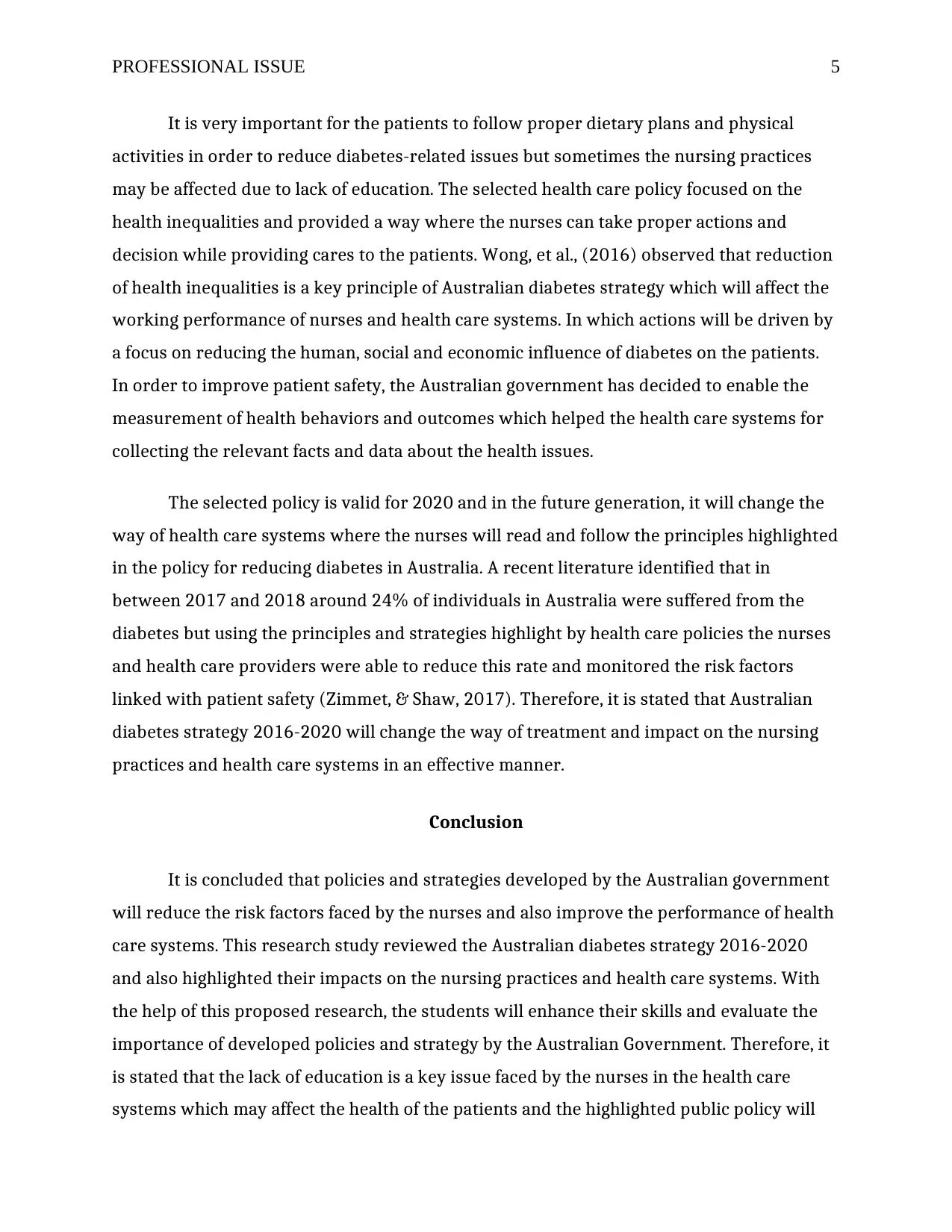
PROFESSIONAL ISSUE 5
It is very important for the patients to follow proper dietary plans and physical
activities in order to reduce diabetes-related issues but sometimes the nursing practices
may be affected due to lack of education. The selected health care policy focused on the
health inequalities and provided a way where the nurses can take proper actions and
decision while providing cares to the patients. Wong, et al., (2016) observed that reduction
of health inequalities is a key principle of Australian diabetes strategy which will affect the
working performance of nurses and health care systems. In which actions will be driven by
a focus on reducing the human, social and economic influence of diabetes on the patients.
In order to improve patient safety, the Australian government has decided to enable the
measurement of health behaviors and outcomes which helped the health care systems for
collecting the relevant facts and data about the health issues.
The selected policy is valid for 2020 and in the future generation, it will change the
way of health care systems where the nurses will read and follow the principles highlighted
in the policy for reducing diabetes in Australia. A recent literature identified that in
between 2017 and 2018 around 24% of individuals in Australia were suffered from the
diabetes but using the principles and strategies highlight by health care policies the nurses
and health care providers were able to reduce this rate and monitored the risk factors
linked with patient safety (Zimmet, & Shaw, 2017). Therefore, it is stated that Australian
diabetes strategy 2016-2020 will change the way of treatment and impact on the nursing
practices and health care systems in an effective manner.
Conclusion
It is concluded that policies and strategies developed by the Australian government
will reduce the risk factors faced by the nurses and also improve the performance of health
care systems. This research study reviewed the Australian diabetes strategy 2016-2020
and also highlighted their impacts on the nursing practices and health care systems. With
the help of this proposed research, the students will enhance their skills and evaluate the
importance of developed policies and strategy by the Australian Government. Therefore, it
is stated that the lack of education is a key issue faced by the nurses in the health care
systems which may affect the health of the patients and the highlighted public policy will
It is very important for the patients to follow proper dietary plans and physical
activities in order to reduce diabetes-related issues but sometimes the nursing practices
may be affected due to lack of education. The selected health care policy focused on the
health inequalities and provided a way where the nurses can take proper actions and
decision while providing cares to the patients. Wong, et al., (2016) observed that reduction
of health inequalities is a key principle of Australian diabetes strategy which will affect the
working performance of nurses and health care systems. In which actions will be driven by
a focus on reducing the human, social and economic influence of diabetes on the patients.
In order to improve patient safety, the Australian government has decided to enable the
measurement of health behaviors and outcomes which helped the health care systems for
collecting the relevant facts and data about the health issues.
The selected policy is valid for 2020 and in the future generation, it will change the
way of health care systems where the nurses will read and follow the principles highlighted
in the policy for reducing diabetes in Australia. A recent literature identified that in
between 2017 and 2018 around 24% of individuals in Australia were suffered from the
diabetes but using the principles and strategies highlight by health care policies the nurses
and health care providers were able to reduce this rate and monitored the risk factors
linked with patient safety (Zimmet, & Shaw, 2017). Therefore, it is stated that Australian
diabetes strategy 2016-2020 will change the way of treatment and impact on the nursing
practices and health care systems in an effective manner.
Conclusion
It is concluded that policies and strategies developed by the Australian government
will reduce the risk factors faced by the nurses and also improve the performance of health
care systems. This research study reviewed the Australian diabetes strategy 2016-2020
and also highlighted their impacts on the nursing practices and health care systems. With
the help of this proposed research, the students will enhance their skills and evaluate the
importance of developed policies and strategy by the Australian Government. Therefore, it
is stated that the lack of education is a key issue faced by the nurses in the health care
systems which may affect the health of the patients and the highlighted public policy will
⊘ This is a preview!⊘
Do you want full access?
Subscribe today to unlock all pages.

Trusted by 1+ million students worldwide
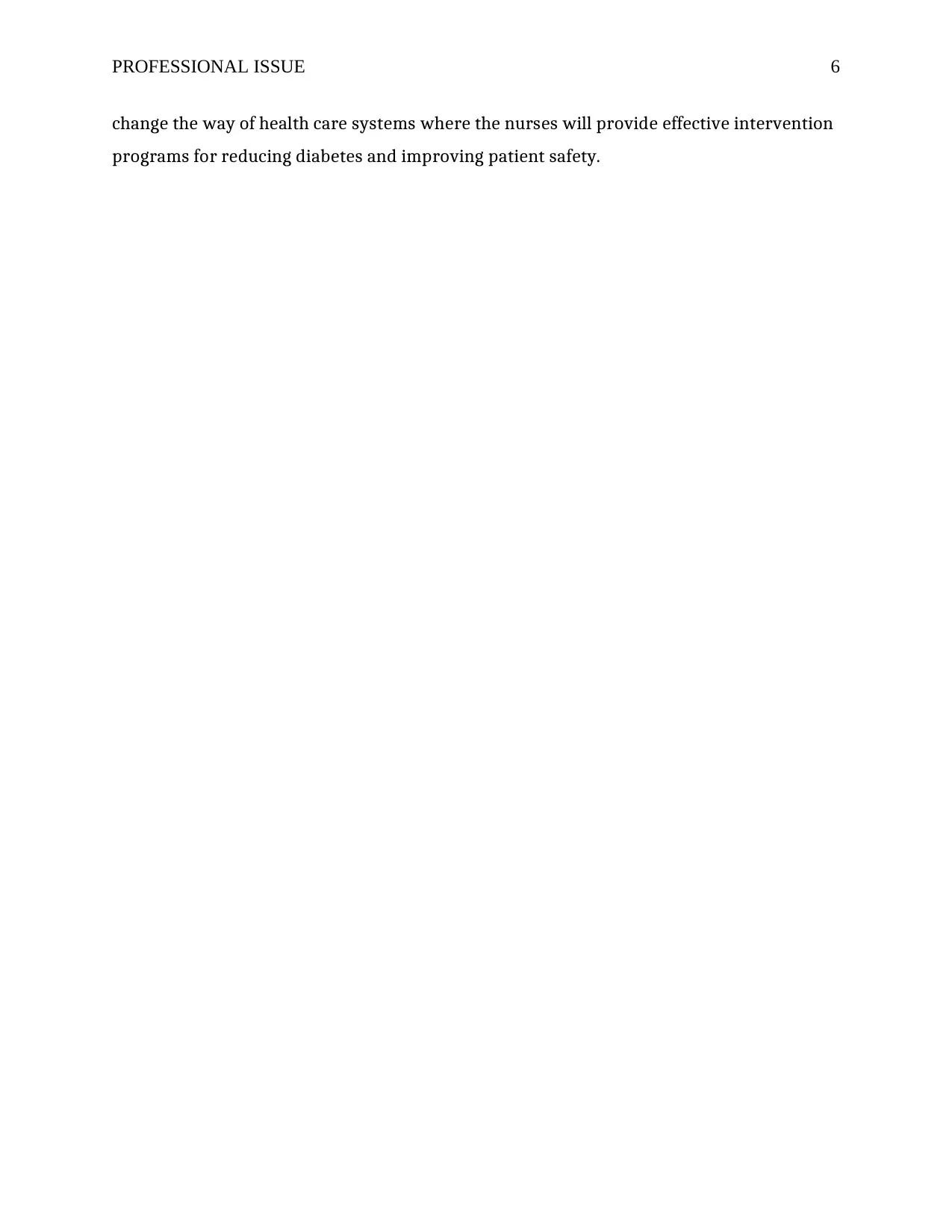
PROFESSIONAL ISSUE 6
change the way of health care systems where the nurses will provide effective intervention
programs for reducing diabetes and improving patient safety.
change the way of health care systems where the nurses will provide effective intervention
programs for reducing diabetes and improving patient safety.
Paraphrase This Document
Need a fresh take? Get an instant paraphrase of this document with our AI Paraphraser
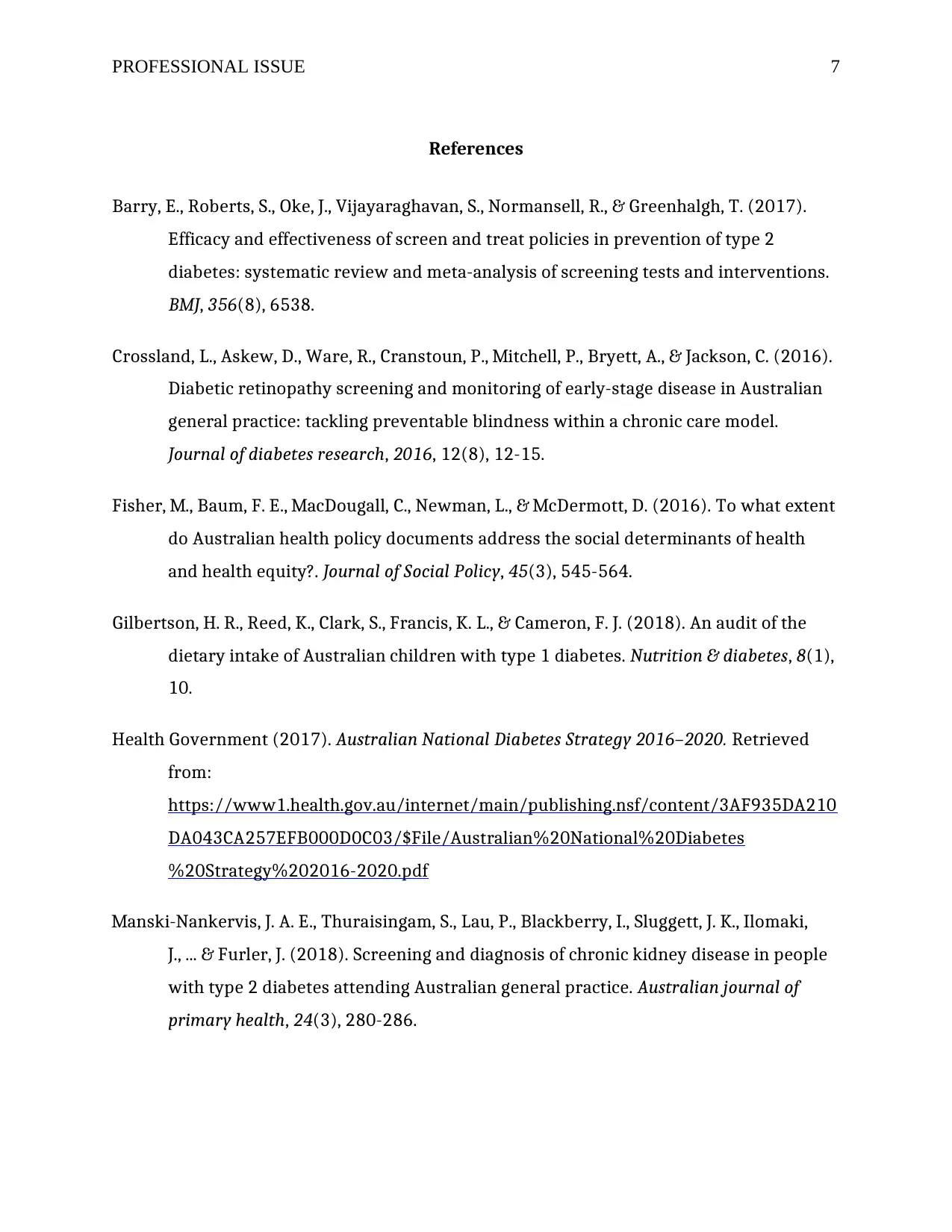
PROFESSIONAL ISSUE 7
References
Barry, E., Roberts, S., Oke, J., Vijayaraghavan, S., Normansell, R., & Greenhalgh, T. (2017).
Efficacy and effectiveness of screen and treat policies in prevention of type 2
diabetes: systematic review and meta-analysis of screening tests and interventions.
BMJ, 356(8), 6538.
Crossland, L., Askew, D., Ware, R., Cranstoun, P., Mitchell, P., Bryett, A., & Jackson, C. (2016).
Diabetic retinopathy screening and monitoring of early-stage disease in Australian
general practice: tackling preventable blindness within a chronic care model.
Journal of diabetes research, 2016, 12(8), 12-15.
Fisher, M., Baum, F. E., MacDougall, C., Newman, L., & McDermott, D. (2016). To what extent
do Australian health policy documents address the social determinants of health
and health equity?. Journal of Social Policy, 45(3), 545-564.
Gilbertson, H. R., Reed, K., Clark, S., Francis, K. L., & Cameron, F. J. (2018). An audit of the
dietary intake of Australian children with type 1 diabetes. Nutrition & diabetes, 8(1),
10.
Health Government (2017). Australian National Diabetes Strategy 2016–2020. Retrieved
from:
https://www1.health.gov.au/internet/main/publishing.nsf/content/3AF935DA210
DA043CA257EFB000D0C03/$File/Australian%20National%20Diabetes
%20Strategy%202016-2020.pdf
Manski-Nankervis, J. A. E., Thuraisingam, S., Lau, P., Blackberry, I., Sluggett, J. K., Ilomaki,
J., ... & Furler, J. (2018). Screening and diagnosis of chronic kidney disease in people
with type 2 diabetes attending Australian general practice. Australian journal of
primary health, 24(3), 280-286.
References
Barry, E., Roberts, S., Oke, J., Vijayaraghavan, S., Normansell, R., & Greenhalgh, T. (2017).
Efficacy and effectiveness of screen and treat policies in prevention of type 2
diabetes: systematic review and meta-analysis of screening tests and interventions.
BMJ, 356(8), 6538.
Crossland, L., Askew, D., Ware, R., Cranstoun, P., Mitchell, P., Bryett, A., & Jackson, C. (2016).
Diabetic retinopathy screening and monitoring of early-stage disease in Australian
general practice: tackling preventable blindness within a chronic care model.
Journal of diabetes research, 2016, 12(8), 12-15.
Fisher, M., Baum, F. E., MacDougall, C., Newman, L., & McDermott, D. (2016). To what extent
do Australian health policy documents address the social determinants of health
and health equity?. Journal of Social Policy, 45(3), 545-564.
Gilbertson, H. R., Reed, K., Clark, S., Francis, K. L., & Cameron, F. J. (2018). An audit of the
dietary intake of Australian children with type 1 diabetes. Nutrition & diabetes, 8(1),
10.
Health Government (2017). Australian National Diabetes Strategy 2016–2020. Retrieved
from:
https://www1.health.gov.au/internet/main/publishing.nsf/content/3AF935DA210
DA043CA257EFB000D0C03/$File/Australian%20National%20Diabetes
%20Strategy%202016-2020.pdf
Manski-Nankervis, J. A. E., Thuraisingam, S., Lau, P., Blackberry, I., Sluggett, J. K., Ilomaki,
J., ... & Furler, J. (2018). Screening and diagnosis of chronic kidney disease in people
with type 2 diabetes attending Australian general practice. Australian journal of
primary health, 24(3), 280-286.
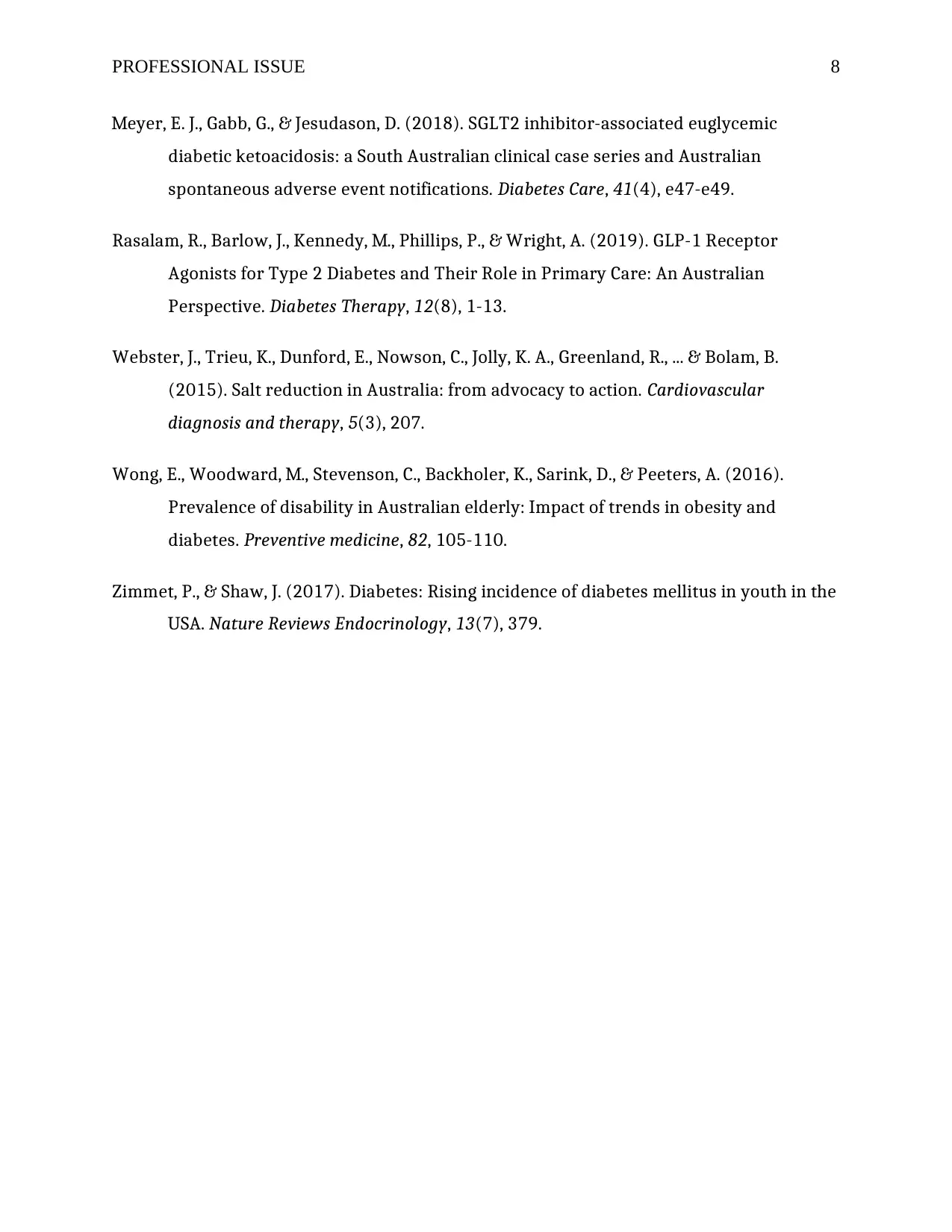
PROFESSIONAL ISSUE 8
Meyer, E. J., Gabb, G., & Jesudason, D. (2018). SGLT2 inhibitor-associated euglycemic
diabetic ketoacidosis: a South Australian clinical case series and Australian
spontaneous adverse event notifications. Diabetes Care, 41(4), e47-e49.
Rasalam, R., Barlow, J., Kennedy, M., Phillips, P., & Wright, A. (2019). GLP-1 Receptor
Agonists for Type 2 Diabetes and Their Role in Primary Care: An Australian
Perspective. Diabetes Therapy, 12(8), 1-13.
Webster, J., Trieu, K., Dunford, E., Nowson, C., Jolly, K. A., Greenland, R., ... & Bolam, B.
(2015). Salt reduction in Australia: from advocacy to action. Cardiovascular
diagnosis and therapy, 5(3), 207.
Wong, E., Woodward, M., Stevenson, C., Backholer, K., Sarink, D., & Peeters, A. (2016).
Prevalence of disability in Australian elderly: Impact of trends in obesity and
diabetes. Preventive medicine, 82, 105-110.
Zimmet, P., & Shaw, J. (2017). Diabetes: Rising incidence of diabetes mellitus in youth in the
USA. Nature Reviews Endocrinology, 13(7), 379.
Meyer, E. J., Gabb, G., & Jesudason, D. (2018). SGLT2 inhibitor-associated euglycemic
diabetic ketoacidosis: a South Australian clinical case series and Australian
spontaneous adverse event notifications. Diabetes Care, 41(4), e47-e49.
Rasalam, R., Barlow, J., Kennedy, M., Phillips, P., & Wright, A. (2019). GLP-1 Receptor
Agonists for Type 2 Diabetes and Their Role in Primary Care: An Australian
Perspective. Diabetes Therapy, 12(8), 1-13.
Webster, J., Trieu, K., Dunford, E., Nowson, C., Jolly, K. A., Greenland, R., ... & Bolam, B.
(2015). Salt reduction in Australia: from advocacy to action. Cardiovascular
diagnosis and therapy, 5(3), 207.
Wong, E., Woodward, M., Stevenson, C., Backholer, K., Sarink, D., & Peeters, A. (2016).
Prevalence of disability in Australian elderly: Impact of trends in obesity and
diabetes. Preventive medicine, 82, 105-110.
Zimmet, P., & Shaw, J. (2017). Diabetes: Rising incidence of diabetes mellitus in youth in the
USA. Nature Reviews Endocrinology, 13(7), 379.
⊘ This is a preview!⊘
Do you want full access?
Subscribe today to unlock all pages.

Trusted by 1+ million students worldwide
1 out of 9
Related Documents
Your All-in-One AI-Powered Toolkit for Academic Success.
+13062052269
info@desklib.com
Available 24*7 on WhatsApp / Email
![[object Object]](/_next/static/media/star-bottom.7253800d.svg)
Unlock your academic potential
Copyright © 2020–2025 A2Z Services. All Rights Reserved. Developed and managed by ZUCOL.





